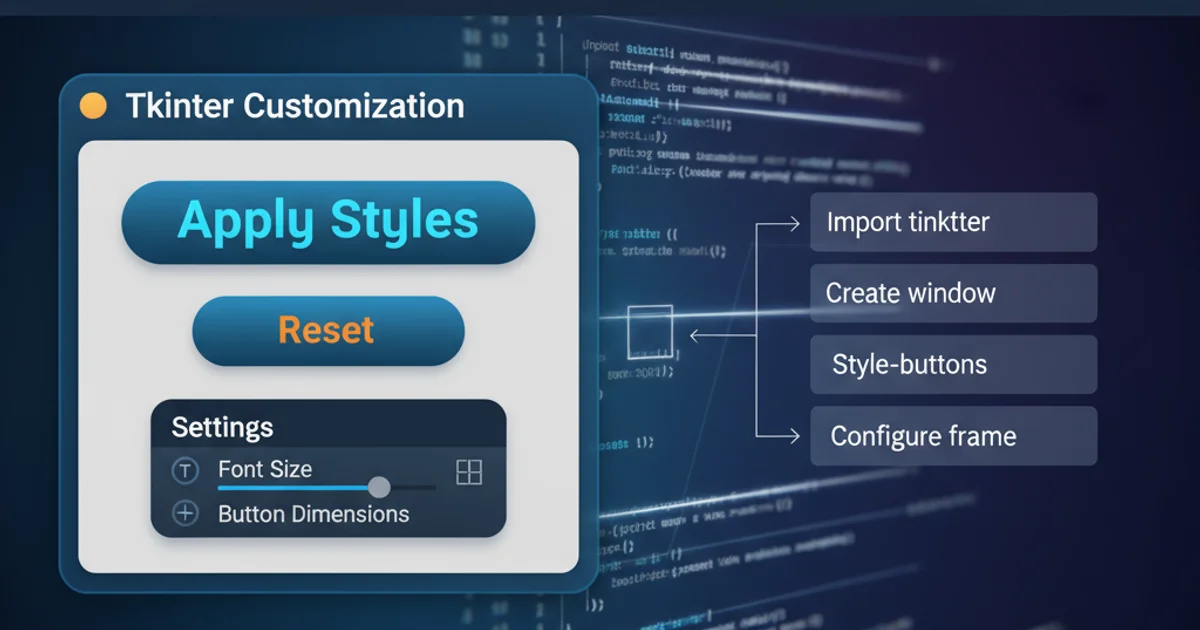How to change font and size of buttons and frame in tkinter using python?
Categories:
Customizing Tkinter Widget Fonts and Sizes

Learn how to effectively change the font family, size, and style of buttons and frames in Tkinter applications using Python, enhancing your GUI's aesthetics and user experience.
Tkinter, Python's standard GUI (Graphical User Interface) toolkit, provides a straightforward way to create desktop applications. While its default widgets are functional, customizing their appearance, such as fonts and sizes, is crucial for creating visually appealing and user-friendly interfaces. This article will guide you through the process of modifying fonts and sizes for common Tkinter widgets like buttons and frames, offering practical code examples and best practices.
Understanding Tkinter Font Configuration
Tkinter offers several ways to manage fonts. The most common and flexible approach is to use the tkinter.font module, which allows you to create font objects that can then be applied to various widgets. Alternatively, you can specify font properties directly as a string, though this is less flexible for complex configurations or dynamic changes.
flowchart TD
A[Start Tkinter App] --> B{Define Font Properties?}
B -- Yes --> C[Create `tkinter.font.Font` object]
B -- No --> D[Use default font or string format]
C --> E[Apply Font to Widget (e.g., Button, Label)]
D --> E
E --> F[Configure Widget Size/Padding]
F --> G[Display GUI]
G --> H[End]Flowchart illustrating the process of configuring fonts in Tkinter.
Changing Button Font and Size
Buttons are interactive elements, and their appearance significantly impacts user interaction. You can customize a button's font, size, and padding to make it more prominent or to fit your application's design language. The font option accepts either a font object or a font string. The button's size is primarily influenced by its content (text/image) and padding (padx, pady).
import tkinter as tk
import tkinter.font as tkFont
root = tk.Tk()
root.title("Button Font and Size Example")
# 1. Using a tkinter.font.Font object
custom_font = tkFont.Font(family="Helvetica", size=16, weight="bold", slant="italic")
button1 = tk.Button(
root,
text="Custom Font Button",
font=custom_font,
padx=20, # Horizontal padding
pady=10 # Vertical padding
)
button1.pack(pady=10)
# 2. Using a font string (less flexible but quick)
button2 = tk.Button(
root,
text="String Font Button",
font="Arial 14 underline", # Family, size, style
padx=15,
pady=8
)
button2.pack(pady=10)
# 3. Changing font after creation
def change_button3_font():
button3.config(font="Times 18 bold")
button3 = tk.Button(
root,
text="Click to Change Font",
font="Courier 12",
command=change_button3_font
)
button3.pack(pady=10)
root.mainloop()
Python code demonstrating how to set button fonts using tkinter.font objects and font strings, and how to adjust button size with padding.
tkinter.font.Font objects, you can easily modify font properties dynamically by calling methods like config() on the font object itself, and all widgets using that font will update automatically. This is more efficient than reconfiguring each widget individually.Customizing Frame Appearance
Frames are container widgets used to organize other widgets. While frames don't directly have a font option, their size is determined by the size and padding of the widgets they contain, along with their own width, height, padx, and pady options. If you want to display text within a frame with a custom font, you would typically place a Label widget inside the frame and configure the label's font.
import tkinter as tk
import tkinter.font as tkFont
root = tk.Tk()
root.title("Frame Customization Example")
# Define a custom font for labels within the frame
frame_label_font = tkFont.Font(family="Verdana", size=12, weight="normal")
# Create a frame with specific dimensions and padding
my_frame = tk.Frame(
root,
width=300, # Fixed width
height=150, # Fixed height
bg="lightgray",
bd=2, # Border width
relief="groove", # Border style
padx=10, # Internal horizontal padding
pady=10 # Internal vertical padding
)
my_frame.pack(padx=20, pady=20, fill="both", expand=True)
# Add a label inside the frame with the custom font
label_in_frame = tk.Label(
my_frame,
text="Content inside the frame",
font=frame_label_font,
bg="lightgray",
fg="darkblue"
)
label_in_frame.pack(pady=15)
# Add a button inside the frame with a custom font
frame_button_font = tkFont.Font(family="Georgia", size=10)
frame_button = tk.Button(
my_frame,
text="Frame Button",
font=frame_button_font,
padx=5,
pady=3
)
frame_button.pack()
root.mainloop()
Python code demonstrating how to create a frame with specific dimensions and how to apply custom fonts to widgets placed inside it.
width and height for a Frame, it's often more flexible to let the frame's size be determined by its contents and the pack, grid, or place geometry managers. Using padx and pady on the frame itself adds internal spacing around its children.Best Practices for Font and Size Management
Consistent font and size management is key to a professional-looking application. Here are some best practices:
1. Use tkinter.font.Font objects
For better control, reusability, and dynamic updates, always prefer creating tkinter.font.Font objects over simple font strings. This allows you to define a font once and apply it to multiple widgets.
2. Define fonts centrally
If your application uses a consistent theme, define your primary fonts (e.g., 'heading_font', 'body_font') at the beginning of your script or in a configuration class. This makes it easier to maintain and modify your application's typography.
3. Leverage padding for sizing
For buttons and other widgets, use padx and pady to control their internal spacing and thus their visual size, rather than trying to manipulate font size alone. This provides more granular control over the widget's dimensions.
4. Test on different platforms
Fonts can render differently across operating systems. Always test your application's appearance on Windows, macOS, and Linux if cross-platform compatibility is a requirement.